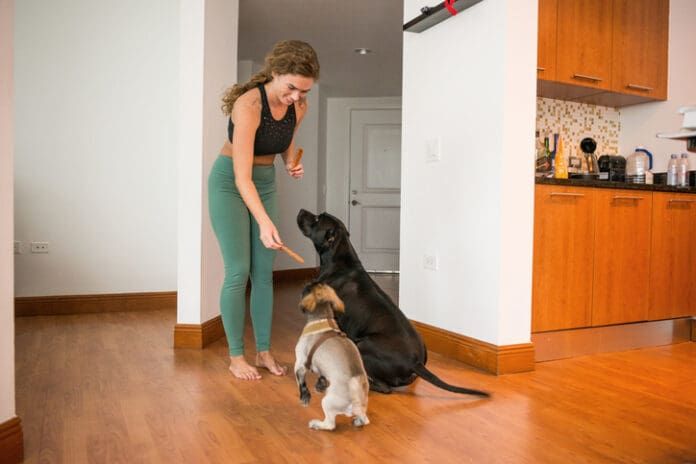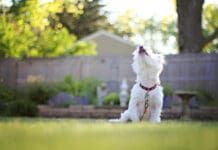Excerpt from Managing A Multi-Dog Household by Pat Miller, CBCC-KA, CPDT-KA, CDBC
Aggression Modification
My first choice with most clients is this: changing the dogs’ opinion of each other through counterconditioning and desensitization (CC&D).
CC&D for intra-pack aggression involves changing your dogs’ association with each other from negative to positive. The easiest way to give most dogs a positive association is with very high-value, really yummy treats. I like to use chicken – canned, baked, or boiled, since most dogs love chicken and it’s a low-fat, low-calorie food.
Here’s how the CC&D process works:
- Determine the distance at which your dogs can be in each other’s presence and be alert or wary but not extremely fearful or aroused. This is called the threshold distance. If one dog has a greater threshold hold distance than the other (often the case), work at the greater distance.
- With you holding Dog A on leash, have your helper appear with Dog B at threshold distance “X.” The instant your dog sees the other, start feeding bits of chicken, non-stop. Your helper will feed chicken to her dog, too, the instant he notices your dog.
- After several seconds, have the helper step out of sight with Dog B, and you both stop feeding chicken.
- Keep repeating steps 1-3 until the sight of the other dog at distance “X” consistently causes both dogs to look at their handlers with a happy smile and a “Yay! Where’s my chicken?” expression. This is the physical presentation of the dogs’ conditioned emotional response (CER); each dog’s association with the other at threshold distance “X” is now positive, so they can deliberately look at you to get their chicken, rather than staying intensely focused on each other.
- Now you need to increase the intensity of the stimulus by increasing the length of time Dog B stays in sight. Continue to feed chicken when they are in view of each, occasionally pausing to let them look at each other again, and immediately feeding chicken when they do.
- When length of time seems to make no difference to either dog – you’re getting a consistent “Yay, where’s my chicken?” response regardless of how long Dog B stays in view, increase the intensity again, this time by increasing Dog B’s movement. Have the handler walk back and forth with her dog, still at distance “X,” slowly at first, then with more energy, even adding in some other behaviors such as sit, down, and roll over.
- Now you’re ready to starting decreasing distance by moving Dog A a little closer to the location where the Dog B will appear. When you obtain consistent CERs from both dogs at each new distance you can decrease the distance a little more, until both dogs are happy to be very near each other.
- Then return to your original threshold distance and increase intensity stimulus by having Dog B move around more and more, as you gradually decrease distance and obtain CERs from both dogs along the way, until they are delighted to be near each other.
- Now go back to your starting distance and increase intensity again, by having both dogs move more naturally as the distance decreases, offering CERs at each new distance before you come any closer, until they can be within six feet of each other, moving around, still relaxed and happy about chicken.
- Finally, find ways for your dogs to engage separately in mutually enjoyable activities together. If they both enjoy car rides, take them for a drive, but be sure they are seat-belted or crated far enough apart to avoid any tension. If they love hiking, take them on “parallel” walks, one with you, one with your training partner, with humans between them at first, and eventually with dogs between humans when you’re sure their emotions are appropriate. Parallel swims, for dogs who love the water, can work well too.
When you feel the dogs are ready to finally interact with each other again, be careful not to undo all your hard work. You might first let them greet through a barrier, such as a baby gate or exercise pen.
Need more help managing your multi-dog household? Check out Whole Dog Journal’s exclusive ebook Managing a Multi-Dog Household.






